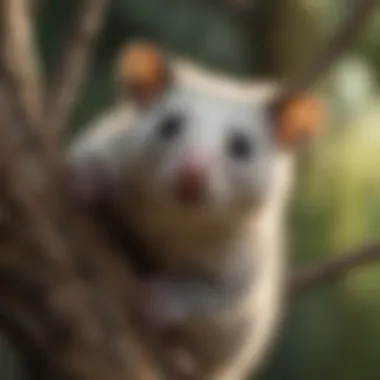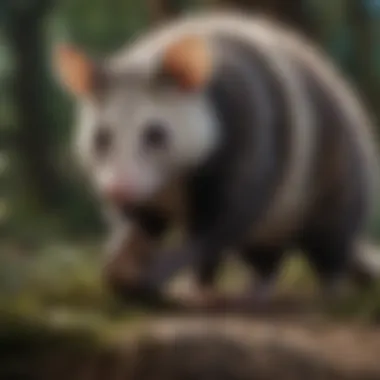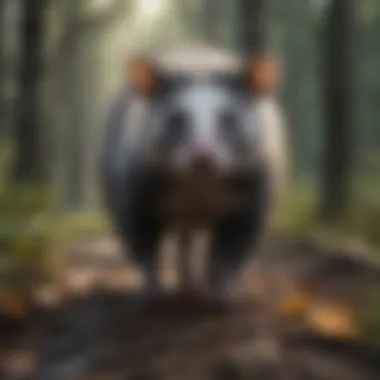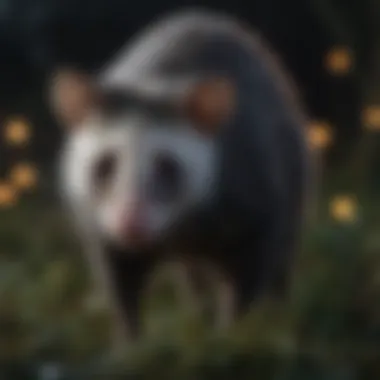Unveiling the Enigmatic Traits of Opossums: An Intriguing Exploration


Animal Species Profile
When delving into the mesmerizing world of opossums, it is essential to understand their uniqueness as an animal species. Opossums, scientifically known as Didelphimorphia, belong to the order of marsupials. These creatures possess distinct physical characteristics that set them apart from other wildlife inhabitants. Their anatomy is notable for features like prehensile tails, hairless ears, and opposable thumbs, making them fascinating subjects for anatomical study. Owing to such peculiar traits, it's evident that opossums are intriguing creatures that warrant closer examination.
Physical Characteristics and Appearance
The physical appearance of opossums is particularly captivating, showcasing a blend of primitive and specialized traits. Opossums typically exhibit a coarse fur coat that varies in coloration, ranging from grayish-white to dark brown, enabling them to blend effectively with diverse environments. Their most striking feature is the rat-like tail, which serves multiple functions, including grasping branches and balancing during complex movements. Additionally, their narrow faces with sharp snouts and dark, beady eyes contribute to their enigmatic charm, making them stand out in the animal kingdom.
Natural Habitat and Distribution
Opossums are known for their adaptability to various habitats, a characteristic that has enabled them to thrive across a wide geographic range. These resilient creatures can be found in diverse environments, including forests, urban areas, and even suburban landscapes. Their distribution spans from North to South America, encompassing a range of ecosystems from tropical rainforests to arid regions. By inhabiting such diverse territories, opossums play a crucial role in ecosystem dynamics, highlighting their significance within the broader realm of wildlife conservation.
Behavior and Social Interactions
The behavior of opossums offers insights into their social dynamics and survival strategies in the wild. Despite their solitary nature, opossums exhibit communal behaviors during mating and nurturing periods. Their nocturnal habits contribute to their elusive nature, allowing them to avoid potential predators and conflicts. Furthermore, opossums showcase intriguing behaviors such as playing dead when faced with threats, a defense mechanism that has fascinated researchers for decades. By unraveling the intricacies of opossum behavior, it becomes evident that these creatures possess a complexity that merits thorough exploration.
Introduction to Opossums
In delving into the intricate world of opossums, it is crucial to acknowledge their unique place in the animal kingdom. Opossums, belonging to the marsupial family, showcase a myriad of remarkable characteristics that set them apart from other mammals. This section serves as a gateway to understanding the biological marvel that is the opossum. By exploring their anatomy, behavior, and ecological roles, we unravel the mysteries behind these enigmatic creatures.
An Overview of Opossums
Their Classification and Taxonomy
The classification and taxonomy of opossums offer a structured framework for comprehending the diversity within this species. Understanding their genetic lineage and evolutionary relationships can provide valuable insights into their adaptations and survival strategies. By highlighting the key branches of their family tree, we gain a deeper appreciation for the complexity of the opossum's genetic makeup and its relevance to ecological systems. Their classification not only distinguishes them from other mammals but also showcases their unique evolutionary path.
Habitat and Distribution
Exploring the habitat and distribution patterns of opossums unveils the geographical preferences and environmental necessities crucial for their survival. By investigating their preferred ecosystems and ranging habits, we gain valuable information on how opossums interact with their surroundings. The unique adaptability of opossums to diverse habitats makes them resilient in the face of changing environmental conditions. Understanding their habitat requirements aids in conservation efforts and promoting coexistence between opossums and other species.
Evolutionary History of Opossums


Origins and Ancestral Roots
The origins and ancestral roots of opossums trace back to ancient history, revealing the intricate evolutionary journey that led to their current form. By studying their genetic heritage and ancestral connections, we unveil the adaptive strategies that enabled opossums to thrive in various ecosystems. Their unique adaptations reflect a long history of survival tactics that have been honed over generations, making them resilient creatures in the face of environmental challenges.
Adaptations Over Time
The adaptations of opossums over time showcase their remarkable ability to evolve in response to changing environmental pressures. From physiological modifications to behavioral adjustments, opossums have displayed an impressive capacity to adapt and thrive in diverse habitats. Understanding the mechanisms behind their evolutionary successes sheds light on the intricate relationship between opossums and their ever-changing environment. Their resilience and versatility stand as a testament to the fascinating evolutionary journey of these enigmatic marsupials.
Physical Attributes of Opossums
In this comprehensive guide on opossums, the section on physical attributes plays a vital role in shedding light on the unique characteristics that define these fascinating marsupials. Opossums possess distinctive features that set them apart in the animal kingdom. Their physical attributes not only showcase their evolutionary adaptations but also contribute to their survival in various habitats. Understanding the physical traits of opossums elevates our admiration for these resilient creatures and deepens our knowledge of their ecological significance.
Distinctive Features
Glossy Fur and Prehensile Tails
A notable aspect of opossums is their glossy fur and prehensile tails. The glossy fur provides both protection from elements and enhances their aesthetic appeal in the wild. Additionally, the prehensile tails enable opossums to navigate their arboreal environments with agility, showcasing their adaptability and dexterity in various settings. The unique feature of glossy fur and prehensile tails underscores the evolutionary success of opossums and emphasizes their prowess in foraging for food and escaping potential threats.
Facial Characteristics
Examining the facial characteristics of opossums reveals interesting insights into their behavioral patterns and sensory capabilities. Their facial features, including whiskers and unique markings, aid in their nocturnal activities by enhancing their sensory perception in low-light conditions. Understanding these facial characteristics provides a glimpse into the sophisticated adaptations of opossums and highlights how their physical attributes shape their interactions with the surrounding environment.
Anatomical Insights
Teeth Structure and Jaw Function
Delving into the teeth structure and jaw function of opossums uncovers their specialized adaptations for omnivorous diets. The unique dentition of opossums allows them to consume a wide range of foods, from fruits to insects, showcasing their versatility as opportunistic feeders in diverse ecosystems. The efficient jaw function further enhances their feeding efficiency, demonstrating the evolutionary advantages of their anatomical features in obtaining nutrients essential for survival.
Pouch Development
The pouch development in female opossums stands out as a remarkable anatomical feature that defines their reproductive strategy. The marsupial pouch serves as a protective environment for their young, allowing for the safe development of offspring until they are mature enough to survive independently. This unique feature of pouch development in opossums illustrates the complex reproductive adaptations that enable their continued success as a species in fluctuating environmental conditions.
Behavioral Patterns of Opossums


Behavioral patterns of opossums play a crucial role in understanding their adaptive strategies and survival mechanisms. In this article, we delve deep into the nocturnal behaviors of these intriguing marsupials, shedding light on their foraging strategies and reproductive habits. By exploring these specific elements, we uncover the significance of behavioral patterns in elucidating the behavioral ecology of opossums.
Nocturnal Behaviors
Nocturnal behaviors, including foraging strategies and reproductive habits, are key components of the opossum's lifestyle. Let's dissect these nocturnal activities further to grasp a comprehensive view of their behavioral repertoire.
Foraging Strategies
Foraging strategies form the backbone of the opossum's survival tactics, guiding their quest for sustenance under the moonlit sky. The distinctiveness of their foraging strategies lies in the methodical approach employed to scavenge for food in a nocturnal setting. This nocturnal foraging behavior serves as a vital adaptation ensuring their dietary needs are met efficiently.
Reproductive Habits
The reproductive habits of opossums reveal intricate patterns of mating, gestation, and offspring rearing in the nighttime realm. Understanding the nuances of their reproductive habits unveils the species' ability to propagate effectively in varied habitats. Despite the challenges posed by the cover of darkness, these reproductive tactics have evolved to optimize success rates, ensuring the continuity of their lineage.
Defense Mechanisms
In addition to their nocturnal behaviors, opossums exhibit fascinating defense mechanisms essential for thwarting potential threats in their environment. Two primary defense strategies, namely playing dead and physical intimidation, showcase the adaptive prowess of these resilient mammals.
Playing Dead
Possessing the ability to play dead with astounding realism, opossums utilize this defense mechanism as a last resort against predators. A key characteristic of playing dead is the physiological response that mimics lifelessness, thereby deceiving adversaries. This unique feature provides opossums with a strategic advantage, creating confusion and offering a chance of escape from perilous situations.
Physical Intimidation
When confrontation escalates, opossums resort to physical intimidation to ward off threats. By showcasing intimidating behaviors such as hissing, baring teeth, or puffing up their fur, they deter potential aggressors effectively. The distinctive feature of physical intimidation lies in its ability to establish dominance without engaging in direct combat, ensuring their safety in the face of adversity.
Ecological Importance of Opossums
Opossums play a crucial role in maintaining ecological balance due to their unique characteristics and behaviors. Being opportunistic feeders, opossums serve as valuable scavengers and clean-up crews within their ecosystems. Their diet consists of a diverse range of food, including carrion, insects, fruits, and smaller animals, which aids in reducing potential disease spread and maintaining cleanliness in their habitats. This scavenging behavior not only helps in recycling nutrients but also contributes to waste decomposition. Opossums, with their innate ability to consume decaying matter without contracting diseases, act as nature's cleaners, ensuring a healthier environment for other species.
Role in Ecosystems


As Scavengers and Clean-Up Crews
Opossums' role as scavengers and clean-up crews is vital in ecosystem dynamics. Their scavenging behavior helps in controlling the spread of diseases by eliminating carrion, reducing the risk of pathogens affecting other wildlife and even humans. By consuming insects and smaller pests, opossums serve as natural pest controllers, aiding in maintaining insect populations within reasonable levels. Additionally, their presence prevents the accumulation of organic matter, contributing to habitat cleanliness and reducing potential environmental hazards.
Impact on Pest Control
Opossums' impact on pest control is noteworthy. Their diet includes insects such as beetles, cockroaches, and ticks, which are known to cause harm to humans and other animals. By feeding on these pests, opossums assist in regulating their populations naturally, minimizing the need for chemical control methods that might have adverse effects on the ecosystem. This natural form of pest management helps in preserving the ecological balance and promoting a sustainable environment for all species.
Interactions with Other Species
Commensal Relationships
Opossums engage in commensal relationships with certain species, where they benefit without causing harm. For example, opossums may seek shelter in abandoned burrows of other animals, utilizing existing structures without impacting the host species. In return, opossums' presence might deter smaller predators, offering indirect protection to their host's offspring. This mutually beneficial relationship showcases how opossums adapt to their environments and establish harmonious coexistence with diverse species.
Predator-Prey Dynamics
The predator-prey dynamics involving opossums highlight their resilience and survival strategies. As prey animals, opossums face predation from various predators, including owls, foxes, and domestic pets. Their adaptive behaviors, such as nocturnal habits and adept climbing skills, help in evading predators and increasing their chances of survival. Understanding these predator-prey relationships sheds light on the complex interactions within ecosystems and emphasizes the importance of opossums in maintaining biodiversity.
Human-Opossum Coexistence
Urban Adaptation
Opossums in Residential Areas
Opossums have displayed a remarkable ability to adapt to residential areas, making them a common sight in urban environments. Their presence in residential spaces provides a unique opportunity to observe these fascinating creatures up close. Despite the misconceptions surrounding opossums, they play a crucial role in maintaining ecological balance by preying on pests and contributing to the local ecosystem's health. Their distinctive foraging habits and resourceful nature make them valuable allies in pest control efforts. However, challenges such as habitat loss and vehicle collisions pose significant threats to opossum populations in residential settings.
Challenges of Urbanization
Urbanization presents a myriad of challenges for opossums and other wildlife species. The rapid expansion of urban areas encroaches upon natural habitats, forcing opossums to adapt to fragmented landscapes. This fragmentation can lead to genetic isolation and reduced biodiversity within opossum populations. Additionally, urban development poses risks such as toxic exposure to pollutants and heightened human-wildlife conflicts. Balancing urbanization with conservation efforts is crucial to safeguarding opossum populations and preserving their role in ecosystems.
Conservation Concerns
Threats to Opossum Populations
Opossum populations face various threats in their natural habitats, ranging from habitat destruction to human persecution. Encroachment of urban areas into wilderness territories threatens the survival of these marsupials, leading to population declines. Factors such as deforestation, pollution, and illegal hunting contribute to the ongoing decline of opossum populations globally. Understanding these threats is essential for formulating effective conservation strategies to protect opossums and their fragile ecosystems.
Conservation Efforts
Conservation initiatives play a crucial role in mitigating the impact of anthropogenic activities on opossum populations. Efforts aimed at habitat restoration, wildlife corridors establishment, and public awareness campaigns are vital in safeguarding opossum habitats and promoting their conservation. Additionally, research programs focused on opossum behavior and ecology aid in developing evidence-based conservation strategies. By actively engaging in conservation efforts, stakeholders can contribute to preserving opossum populations for future generations to appreciate and admire.







